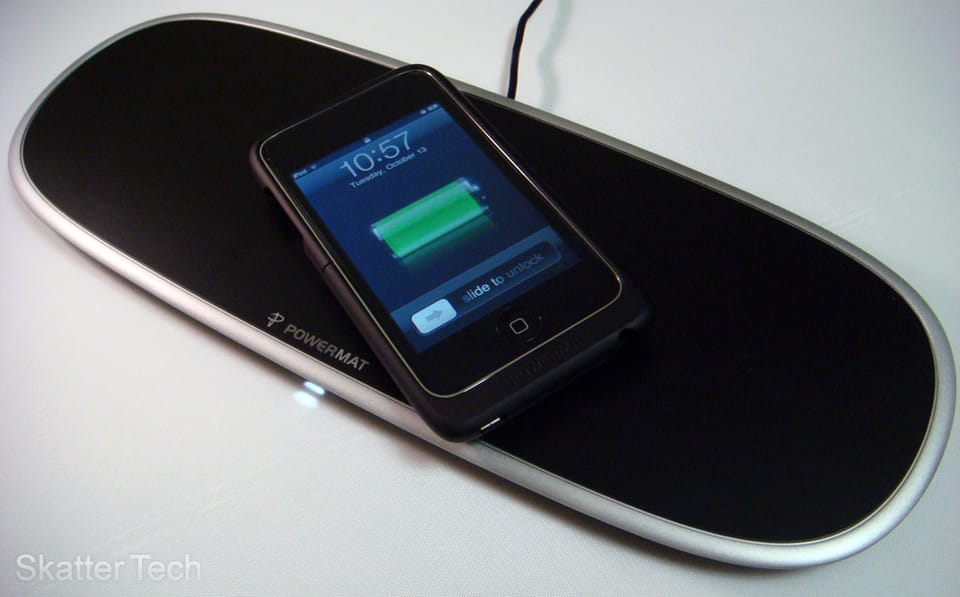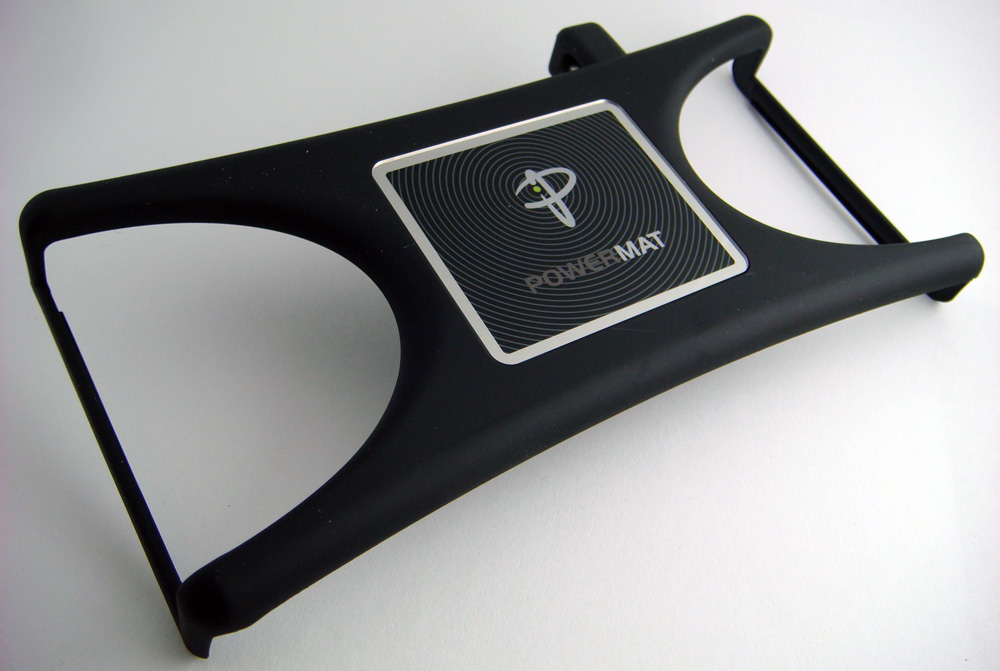Powermat Wireless Chargers (Review)

Using Powermat is quite easy. There’s only one cable needed to power the Powermat itself. Gadgets can be placed on any of the three magnetic charging spots on the device. It plays a futuristic sound and display an LED indicator to verify that it’s charging. If you begin to get annoyed with the sounds once the “coolness-factor” fades, there are buttons on the back to adjust the volume and indicator brightness level as well. An additional powered USB port has been conveniently added to the back to charge legacy devices that don’t yet have support for the Powermat.
Here’s when it gets tricky. The devices you own just don’t charge on their own if you place them on the Powermat. You’ll first need to place them in special Powermat sleeves. There are a number of receivers offered, however we were provided with three: iPod Touch Sleeve, Nintendo DSi Sleeve, and iPod Dock. Their website reveals sleeves for other devices including popular models of the RIM Blackberry. The Powermat representative we spoke with stated that many more accessories for popular gadgets are on their way.

The first device I tested was the iPod Touch Sleeve. I slipped the iPod Touch into the case and placed it on the Powermat. After the Powermat did it’s thing, played a sound and lit up the LED, the iPod Touch displayed the charging screen after a short delay. The case was actually quite a decent one and seemed like it would do a fairly good job of protecting my device. It did unfortunately have that obtruding portion on the back which is necessary for this technology to function. The case also required that I use a little headset dongle and their own USB cable since neither a standard headphone cable or iPod Connector would reach through the case. Although I didn’t see any negative impact to the performance of WiFi on the iPod Touch, I’m not sure if it would cause any signal issues on the case for the iPhone they are releasing this month. Charging worked perfectly and just about as fast, but the need for a headphone dongle made it seem a bit annoying.

The next receiver I tried was the Powermat iPod Dock. At the moment this is a workaround for charging an iPhone 3GS. However the dock also works with the majority of iPods on the market with a few exceptions. It detected and charged both a 2nd generation iPod Nano and iPod Touch perfectly. It also has an adjustable backrest to adjust for the various sizes of these Apple devices. This accessory also seemed to wirelessly charge a device in just about the same time a traditional wired charger would.

Although we only had a standard Nintendo DS, we were able to borrow a Nintendo DSi to test it’s sleeve device briefly. It snapped on easily and immediately began to charge the device. It does add a bit of bulk and make holding the Nintendo DSi a bit more awkward, but it wasn’t too big of an issue. And it was a lot more convenient to place the DSi on the Powermat rather than having to reach for a cable that is probably tangled up or fallen off a desk.


The final accessory we tested the Powermat with was the included and highly versatile Powercube. This was one of my favorite aspects of the entire product. It’s a simple cube that’s placed on the mat with a cable coming out of it. There are plenty of adapters for devices such as Apple, LG, Samsung, Sony, Nintendo, and mini/micro USB products included. Although its not really making anything more cable free, it’s almost a universal charger for the majority of devices out there. We’ve got plenty of gadgets coming in and out at Skatter Tech and this could probably charge just about all of them. Powermat even includes a little storage box that magnetically attaches to the Powercube to carry around a couple of the adapter tips you use most. While this certainly isn’t as awesome as simply placing your iPod or BlackBerry on the Powermat, it’s definitely a welcome addition.
The Powermat works exactly as advertised. We didn’t face any issues or problems. The version we tested is the “Home and Office” version, but Powermat also offers a foldable portable version for travel. A question that a couple of friends asked was, “Is this safe?”. After a little investigating, I found that there’s nothing to be concerned about. The device is fairly low voltage and it wouldn’t have been approved for sale if there were potential health risks. It doesn’t damage any other devices placed near or on it either.
So does the Powermat have a catch? Yes, the price. The base unit sells for about $100 alone. Although it includes a Powercube and those set of adapters pictured above, it’s still expensive. Plus, each of the device-specific sleeves sell separately for around $30 each. Sure, if you’ve got the cash to spare, go for it. It works. I loved the simplicity of not having to plug my devices in, but I don’t necessarily think it’s worth spending that much. Plus this technology has already been natively implemented into devices such as the Palm Pre. Dell even showed off the Latitude Z laptop that charges without cables. This technology is closer than ever and I wouldn’t be surprised if it appeared in a lot more gadgets we use everyday. I’m sure we’ll be seeing a lot of those as early next year during the 2010 Consumer Electronics Show. In the meantime, it might just be best for the rest of us to wait until prices drop or until it becomes a built-in feature of new versions of gadgets that hit the streets.
Buy: Powermat for $99 | Accessories
Related: Powermat Video Demo
Links: Powermat.com